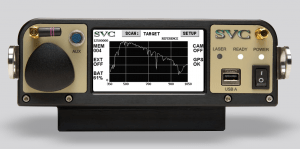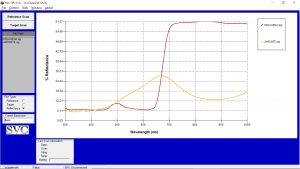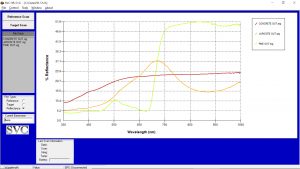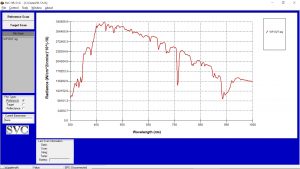HR-512i
The SVC HR-512i is our 350 nm to 1050 nm region instrument with medium spectral resolution in the NIR region. This is a great option when your application only needs the 350-1050 nm spectral range.
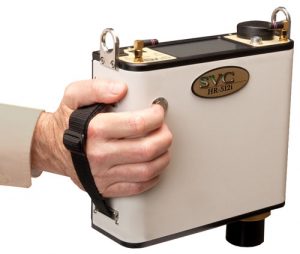
HR-512i Specifications | |||
| Spectral Range | 350 nm – 1050 nm | ||
| Internal Memory | 1000 scans | ||
| Channels | 512 | ||
| Linear Array | (1) 512ch Si, 350 – 1050 nm | ||
| Spectral Resolution (FWHM) | 3.2 nm, 700 nm | ||
| Bandwidth (nominal) | 1.5 nm, 350 – 1050 nm | ||
| Minimum Integration | 10 millisecond | ||
| FOV | 4˚ standard, 8˚, 25˚ optional armored fiber optic | ||
| Noise Equivalent Radiance | ≤ 0.8 x 10-9 W/cm2/nm/sr @ 700 nm | ||
| Stand Alone Measurements (no computer required) | Standard | ||
| Calibration Accuracy (NIST Traceable) | ±5% @ 400 nm ±4% @ 700 nm | ||
| Wavelength Reproducibility | 0.1 nm | ||
| Dark Current Correction | Automatic | ||
| Spectrum Averaging | Automatic/selectable | ||
| Internal Digital Camera | Supplied | ||
| Internal GPS | Supplied | ||
Physical Specifications | |||
| Head Size | 8.75” x 6.5” x 3.0” | ||
| Weight | 5.2lbs., 2.4kg | ||
| Battery Type | 7.4 V lithium ion | ||
| Battery Life | 8 hours approximately | ||
HR-512i Details
The SVC HR-512i has all the features of the other i-Series instrument.
Designed for maximum optical performance the SVC HR-512i has:
- Co-aligned symmetrical and uniform field of view
- Full conical field of view eliminating spectral discontinuities and step discontinuities at the spectrometer sensor interfaces
- Conical field of view gives better measurement data for all surfaces, especially heterogeneous surfaces
Sample Scans
Features
And the HR-512i delivers the highest quality data with industry leading ease of use:
- Data stored in the built-in computer – no external computer to carry in the field
- Scene photos and GPS coordinates stored with every file, so you know exactly what the conditions were for each scan
- Two Bluetooth devices allows the instrument to receive data from an external sensor suite containing up to 16 separate sensors. The sensor suite can include downwelling sensors supplying instantaneous broad or narrow band solar response. The sensor data is stored with the spectral data file, allowing the researcher to understand changes in solar irradiance and assist in corrections
- Other environmental sensors are available.

